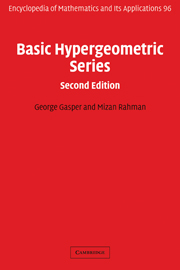Book contents
- Frontmatter
- Contents
- Foreword
- Preface
- Preface to the second edition
- 1 Basic hypergeometric series
- 2 Summation, transformation, and expansion formulas
- 3 Additional summation, transformation, and expansion formulas
- 4 Basic contour integrals
- 5 Bilateral basic hypergeometric series
- 6 The Askey–Wilson q-beta integral and some associated formulas
- 7 Applications to orthogonal polynomials
- 8 Further applications
- 9 Linear and bilinear generating functions for basic orthogonal polynomials
- 10 q-series in two or more variables
- 11 Elliptic, modular, and theta hypergeometric series
- Appendix I Identities involving q-shifted factorials, q-gamma functions and q-binomial coefficients
- Appendix II Selected summation formulas
- Appendix III Selected transformation formulas
- References
- Symbol index
- Author index
- Subject index
10 - q-series in two or more variables
Published online by Cambridge University Press: 24 November 2009
- Frontmatter
- Contents
- Foreword
- Preface
- Preface to the second edition
- 1 Basic hypergeometric series
- 2 Summation, transformation, and expansion formulas
- 3 Additional summation, transformation, and expansion formulas
- 4 Basic contour integrals
- 5 Bilateral basic hypergeometric series
- 6 The Askey–Wilson q-beta integral and some associated formulas
- 7 Applications to orthogonal polynomials
- 8 Further applications
- 9 Linear and bilinear generating functions for basic orthogonal polynomials
- 10 q-series in two or more variables
- 11 Elliptic, modular, and theta hypergeometric series
- Appendix I Identities involving q-shifted factorials, q-gamma functions and q-binomial coefficients
- Appendix II Selected summation formulas
- Appendix III Selected transformation formulas
- References
- Symbol index
- Author index
- Subject index
Summary
Introduction
The main objective of this chapter is to consider q-analogues of Appell's four well-known functions F1, F2, F3 and F4. We start out with Jackson's [1942] φ(1), φ(2), φ(3) and φ(4) functions, defined in terms of double hypergeometric series, which are q-analogues of the Appell functions. It turns out that not all of Jackson's q-Appell functions have the properties that enable them to have transformation and reduction formulas analogous to those for the Appell functions. Also, starting with a q-analogue of the function on one side of a hypergeometric transformation of a reduction formula may lead to a different q-analogue of the formula than starting with a q-analogue of the function on the other side of the formula. We find, further, that the alternative approach of using the q-integral representations of these q-Appell functions can be very fruitful. For example, it immediately leads to the fact that a general φ(1) series is indeed equal to a multiple of a 3ø2 series (see (10.3.4) below). The q-integral approach can be used to derive q-analogues of the Appell functions that are quite different from the ones given by Jackson. In the last section we give a completely different q-analogue of F1, based on the so-called q-quadratic lattice, which has a representation in terms of an Askey-Wilson type integral. We do not attempt to consider Askey-Wilson type q-analogues of F2 and F3 because these are probably the least interesting of the four Appell functions and nothing seems to be known about these analogues.
Information
- Type
- Chapter
- Information
- Basic Hypergeometric Series , pp. 282 - 301Publisher: Cambridge University PressPrint publication year: 2004
